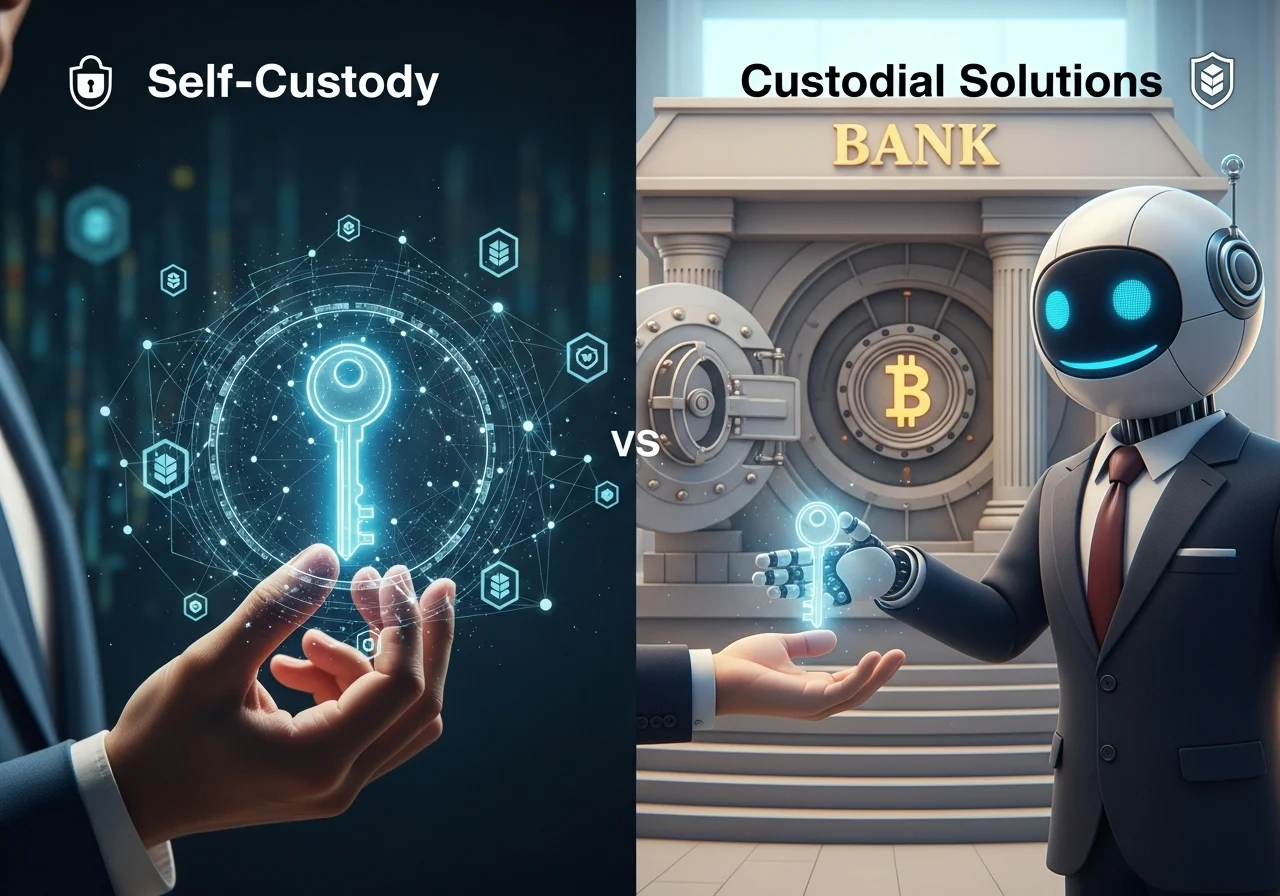Self-Custody vs. Custodial Solutions: A Guide for High-Value Crypto Holders
Table of Contents
What does Self-Custody mean?

Self-Custody means you — and only you — hold the keys to your crypto. Private key in a hardware wallet, seed phrase in a safe, or a multisig arrangement you control. No company can freeze it. No one can recover it for you.
That’s freedom. It’s also responsibility. If you drop the ball, there’s no customer service line to call. You are the firewall.
What are custodial solutions?
Custodial solutions are services that hold crypto for you. Exchanges, institutional custodians, or specialized vaults. You hand over keys to a company that promises security, insurance, and recovery options.
That’s convenience. It’s also trust. You must trust the people running the vault.
Why the choice feels emotional
Money carries stories. For many, crypto is not just an investment — it’s a nest egg for family, a dream home, school fees. When you choose custody, you’re choosing who holds your story if something happens to you.
That’s why the decision isn’t only technical. It’s about trust, personality, and how you sleep at night.
Quick comparison — what you actually gain and risk
- Control (Self-Custody): Full power. You move funds whenever. No one can stop you.
- Recovery (Custodial): Policies and teams exist to help if something goes wrong.
- Risk (Self-Custody): Lose your keys and the funds are likely gone. Human mistakes matter.
- Risk (Custodial): Company hacks, insolvency, regulation or internal fraud. Your access depends on the provider.
Think of it like owning a house (self-custody) versus renting a safe deposit box in a bank (custodial). Each has different dangers and comforts.
Real-world risks of Self-Custody
- Forgotten seed phrase. People underestimate how easy it is to misplace words.
- Single point of failure. If one person holds all keys, estate problems arise.
- Physical loss or damage. Fire, theft, or water can destroy a paper or device.
- Social engineering. Scammers mimic friends or tech support to coax keys out of you.
- Technical errors. Using the wrong wallet software or updating at the wrong time can lock you out.
These are not theoretical. I’ve seen two different people lose access because they stored a paper in a wallet that months later was thrown away with old receipts.
Real-world risks of custodial solutions
- Hacks and insolvency. Exchanges are targets. If a company fails, your claim can be messy.
- Regulatory freezes. Authorities can compel custodians to freeze accounts.
- Privacy loss. Custodians collect KYC and transaction histories.
- Terms and fees. Withdrawal waits, limits, or surprise fees can bite when you need flexibility.
- An error at the custodian. Internal fraud or sloppy procedures are possible.
Custodians can be brilliant at security. They can also fail in ways personal wallets don’t.
Who should prefer which option?
- Choose Self-Custody if: you value control, you can follow disciplined procedures, and you accept the duty of long-term stewardship.
- Choose custodial solutions if: you value convenience, need professional recovery, or prefer an insurance/operational safety net.
- For many people the best answer is a mix — the hybrid approach.
A practical hybrid that actually works
If you hold large sums, consider splitting by purpose:
- Safety reserve: Put a portion with a regulated custodian that offers insurance and audited proof-of-reserves. Use this for long-term core holdings.
- Personal control: Keep a spending or trading stash in a hardware wallet you control.
- Multisig middle ground: Use a multisig setup where you control one key, a trusted partner holds another, and a custodian or professional service holds the third.
This is like keeping most money in a bank, some in a safe at home, and a joint account for shared needs.
Multisig: not magic, but very useful
Multisig means multiple signatures are needed to move funds. A simple, common setup is 2-of-3: any two keys can sign.
Why people like it:
- Reduces single-person failure.
- Guards against one device being stolen.
- Lets you mix friends, family, and professional co-signers.
It requires setup and discipline, but it adds real safety without giving up control entirely.
How to choose a custodian—checklist you can use
- Are they audited? Independent audits matter.
- What does insurance really cover? Read exclusions.
- Where are they regulated? Jurisdiction impacts your rights.
- How do they store keys? Cold storage vs. hot wallets — know the split.
- What are withdrawal rules and delays? Test with small amounts.
- How is customer support — fast, slow, or nonresponsive?
A custodian can be excellent, but due diligence is not optional.
A simple plan to set up Self-Custody safely
- Buy a hardware wallet from a reputable vendor. Don’t accept used devices.
- Generate your seed phrase offline. Write it legibly on a durable medium (metal if you can).
- Make two durable, separate backups. Store them apart — one at a trusted lawyer’s safe, one in a bank safe deposit, for example.
- Use multisig if you can. Start with 2-of-3.
- Keep a brief inheritance note for trusted people. Don’t write seed words into that note. Instead, explain where and how seeds are stored.
- Practice a small recovery drill — move a tiny amount and restore it to confirm your steps work.
Keep the steps simple. Complexity kills.
Checklist for custodial users
- Start small: move a small test amount and withdraw to verify procedures.
- Keep copies of your KYC documents and proof of ownership in a secure place.
- Know how support handles emergencies — phone numbers, escalation steps.
- Periodically check audit reports and custodian news.
- Plan for legal steps if you or your custodian cross jurisdictions.
Again: test before trusting larger sums.
Cost matters, but don’t let it blind you
Self-custody has upfront costs: hardware wallets, safes, and legal fees. Custodians charge ongoing fees and may limit liquidity. Compare lifetime costs with peace of mind.
Often people obsess over fees while underestimating the cost of a single mistake.
Training and rules that actually stick
- Keep your process obvious and repeatable.
- Limit the number of people with access. Fewer hands, fewer mistakes.
- Schedule an annual review. Life changes — update plans when you marry, move, or change jobs.
- Talk to one trusted person about where the plan lives. Not the seed—where the instructions are stored.
Small, simple habits make a far bigger difference than fancy tech.
A conservative example for $5M (realistic)
- $3M in a regulated custodian with insurance and proof-of-reserves.
- $1M in a 2-of-3 multisig across two hardware wallets (you and a co-trustee) and one trusted third signer.
- $1M liquid for near-term use in a hardware wallet with clear, tested backups.
This blends recovery, professional backing, and personal control.
Final thoughts
There is no perfect answer. There is only the plan that matches you. Some of us like total control and the calm that comes with mastering details. Others sleep better knowing a professional handles the complexity. Both choices are valid.
Quick takeaway (easy to glance at)
- Self-Custody = freedom + responsibility.
- Custodial Solutions = convenience + counterparty risk.
- Many high-value holders use a hybrid approach.
- Multisig and clear inheritance plans reduce the “single person disaster.”
- Test everything. Practice small recoveries. Keep instructions simple.
FAQ
Q: I’m new. Should I start with self-custody?
A: Try small. Learn with tiny amounts. Custodial services can be safer for large sums if you’re just starting.
Q: How many backups are enough?
A: Two durable backups in separate secure locations is a good minimum. Add Shamir splitting for extra safety.
Q: Is insurance trustworthy?
A: Insurance helps, but read the policy. Many exclude certain risks like fraud or regulatory seizure.
Q: Who should I name to access my crypto if I can’t?
A: Not the seed phrase. Name a trusted executor and a lawyer. Put clear, simple recovery instructions where they can find them — and test that the person understands.

Hello, I’m Edmilson Dias, founder of CoinBringer. I created this platform to guide people through the fast-moving world of cryptocurrency with clarity and safety. With years of research in blockchain and digital security, my goal is to translate complex topics into practical knowledge, offering reliable tutorials, safety insights, and guidance for both newcomers and experienced users.
Discover more from CoinBringer
Subscribe to get the latest posts sent to your email.







